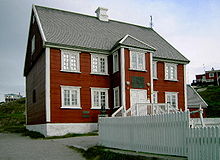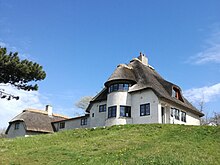Knud Rasmussen
Knud Johan Victor Rasmussen (born June 7, 1879 in Ilulissat , West Greenland , † December 21, 1933 in Copenhagen , Denmark ) was a Greenland-Danish polar explorer , ethnologist and author .
life and work

Rasmussen was the son of the missionary and linguist Christian Rasmussen (1846-1918) and his wife Sofie Louise Rasmussen (1842-1917), née Fleischer, a Greenlandic woman with Norwegian and Inuit ancestry. Even as a young boy he was an excellent dog sled driver by Greenlandic standards . A well-known quote from him is: "Give me snow, give me dogs, and you can keep the rest". His Greenlandic nickname was Kunũnguaĸ ("little knud ").
From 1891 he attended the Latin and Realschule in Nørrebro , a district of Copenhagen. He then studied for a few semesters at the University of Copenhagen , took the Philosophicum , but could not decide on a subject. In 1901 he went to Stockholm as a correspondent to report on the Nordic Games , and then traveled through Lapland and Northern Norway .
From 1902–1904 he took part in the literary expedition to Northwest Greenland with his friend, the painter and draftsman Harald Moltke . This was under the direction of Ludvig Mylius-Erichsen , with whom Rasmussen had already visited Iceland in 1900 . The main objective of the expedition was to record the songs and legends of the Inughuit . In the following years Rasmussen came to Greenland again and again, sometimes on official matters.
On November 11, 1908, Knud Rasmussen married Dagmar Theresa Andersen (1882–1965).
In 1909 he co-founded the first mission station in North Greenland with Gustav Olsen . In 1910, together with Olsen and his partner Peter Freuchen, he founded the Thule trading and research station , which was the starting point for his expeditions. Rasmussen put the profit from the trading station into his expeditions and the establishment of a local infrastructure with a shop, hospital, free medical care and a church. In the no-man's-land under international law and jurisprudence , Rasmussen had the highest authority, which he however used in favor of the Inughuit.
Rasmussen carried out seven expeditions (the so-called " Thule Expeditions ") to northern Greenland and the arctic regions of Canada and Alaska between 1912 and 1933 . In addition to geographical research, the aim was primarily to research and preserve the Eskimo culture , the language ( Inuktitut ), the sagas and stories. On the 1st Thule expedition he crossed the Greenland Ice Sheet twice , discovered Adam Biering Land and traces of earlier settlement on the Independence Fjord . The second Thule expedition took him to the fjords of the north coast of Greenland. Of particular importance was the 5th Thule expedition from 1921 to 1924, which served the aim of clarifying the origin of the Eskimos. The expedition first set up camp on an island in eastern Arctic Canada and visited the Inuit settlements in the greater area. In the spring of 1923, Rasmussen, accompanied by two Inuit, began the longest dog sledding trip in the history of Arctic research, which took him along the north coast of the North American mainland to Nome in Alaska within 16 months .
Knud Rasmussen wrote film history on his last expedition, during which the feature film Palos Brautfahrt , which shows the traditional life of the Eskimos, was made. Rasmussen had written the script and selected the leading actors. He was the patron of the Arnold Fanck film " SOS Eisberg " (with Ernst Udet and Leni Riefenstahl ), which was the first feature film to show the special beauty of Greenland's ice landscapes.
In October 1933, Rasmussen fell ill with meat poisoning in East Greenland and died on December 21 in a Copenhagen hospital.
Thule Air Base has been located in the immediate vicinity of Thule since 1951 . In 1953 the inhabitants were forcibly relocated under pressure from the Americans. Rasmussen's house was dismantled into its individual parts and brought to Qaanaaq in 1986 , where it was rebuilt and has since served as a local museum ( Thule Museum ). Today the Ilulissat Museum is located in Rasmussen's birthplace in Ilulissat, and it is a particular reminder of this most famous of all Greenlanders. Other memorabilia can be found in the Thule Museum in Qaanaaq. Knud Rasmussen's last expedition ship, the Kivioq , built in 1933 , is now privately owned by Jutta Carstensen and Uwe Käding and lies in the port of Aabenraa in southern Denmark.
Honors
Knud Rasmussen has been honored worldwide for his scientific work. He was a Knight of the Danish Order of Danebro , Commander of the Norwegian Order of Saint Olav , Commander of the Finnish Order of the White Rose , Knight of the Swedish Order of the North Star and holder of the Danish Medal of Merit in Gold. He was a member of numerous scientific societies, such as the Geographical Societies of Norway, Sweden , Italy and the United States , as well as the Explorers Club and the Higher Scientific Society in Lund ( Vetenskapssocieteten i Lund ).
The University of Copenhagen (1925) and the Scottish University of St Andrews (1927) awarded Rasmussen an honorary doctorate . The Danish National Museum , which owes him 16,000 items in its collection, has a Knud Rasmussen Hall. Streets around the world are named after Knud Rasmussen. B. in Greifswald , Güstrow , Ingolstadt , Lübeck , Rostock , Vienna and Wilhelmshaven .
A number of geographical objects are named after Knud Rasmussen . These include Knud-Rasmussen-Land , Cape Knud Rasmussen , the Knud-Rasmussen Mountains , the Knud-Rasmussen Glacier and the Knud-Rasmussen-Nunatak in Greenland and the Rasmussen Basin in the Canadian Arctic. The Rasmussen Peninsula in Antarctica bears his name.
Publications
Rasmussen was important as a writer. Some of his books are
- Nye mennesker. 1905 ( New people. A year with the neighbors of the North Pole. - Internet Archive 1907).
- Min rejsedagbog ( My Travel Diary - Across the Greenland Ice Sheet to Peary Land. ) 1915.
- Greenland along Polhavet. Udforskningen af Grønland from Melvillebugten to Cape Morris Jessup. Skildringer from the 2. Thule-ekspedition, 1916–18. 1919 ( In the homeland of the polar man. The second Thule expedition, 1916–18. - Internet Archive 1922.)
- The Singers' War - Eskimo sagas from Greenland. 1922.
- Myter og sagn fra Grønland ( Myths and legends of Greenland ), Gyldendal, Nordisk forlag, 1925.
- Fra Grønland til Stillehavet ( From Greenland to the Pacific. ) 1925–26.
- Rasmussen's Thule ride. 2 years in the sledge through unexplored Eskimo country. Edit and trans. v. Friedrich Sieburg . Ffm. 1926
- Across Arctic America. New York - London 1927 digitized
- Den store slæderejse ( The great sleigh journey. ) 1932.
Rasmussen translated in 1915 the first Greenlandic novel Sinnattugaq of Mathias Storch , entitled En Grønlænders Drøm ( A Greenlandic dream ) into Danish.
literature
- Aenne Schmücker : Knud Rasmussen on the 25th anniversary of his death (PDF; 362 kB). In: Polar Research . Volume 27, 1957, pp. 43-45.
- Kaj Birket-Smith : Knud Rasmussen . In: Journal de la Société des Américanistes. Volume 25, No. 2, 1933, pp. 371-374 (English).
- Lieselotte Düngel-Gilles: Knud Rasmussen . Altberliner Verlag L. Groszer, Berlin 1964.
- Hans Bauer: A life for the Eskimo: The fate of the researcher Knud Rasmussen . FA Brockhaus, Leipzig 1965.
- Kurt L. Frederiksen: Knud Rasmussen - Kongen af Thule . Borgen, Copenhagen 2009, ISBN 978-87-21-03454-2 .
- Edi Wieser: Knud Rasmussen's last trip to Greenland. The Bergland Book, Salzburg 1936.
- C. George Fry: Knud Johan Victor Rasmussen. In: Frank N. Magill (Ed.): Dictionary of World Biography. Volume 9: 20th century, O – Z. Routledge, 1999, ISBN 1-57958-048-3 , pp. 3121 ff. ( Limited preview in the Google book search, English)
- Liz Cruwys: Rasmussen, Knud . In: Mark Nuttall (Ed.): Encyclopedia of the Arctic . tape 3 . Routledge, New York and London 2003, ISBN 1-57958-436-5 , pp. 1743–1745 (English, limited preview in Google Book Search).
- H. Ostermann: Knud Rasmussen . In: Dansk biografisk leksikon 3rd edition, Gyldendal (Danish).
- Ole Ventegodt: Knud Rasmussen . In: The Danske Encyklopædi store . (Danish).
Individual evidence
- ↑ a b Fry: Knud Johan Victor Rasmussen. 1999, p. 3123.
- ↑ Jean Malaurie: Myth of the North Pole. 200 years of expedition history. 2003, p. 261 ( limited preview in Google book search).
Web links
- Literature by and about Knud Rasmussen in the catalog of the German National Library
- Newspaper article about Knud Rasmussen in the press kit of the 20th century of the ZBW - Leibniz Information Center for Economics .
- Knud Rasmussen in the Internet Movie Database (English)
- Ilulissat Museum. greenland.com, accessed November 22, 2016 .
- Thule Museum ( Memento from May 17, 2006 in the Internet Archive )
- Municipal museum site to the Knud Rasmussen House
- Website of the Knud Rasmussen House
- Kivioq in the Træskibs Sammenslutingen ship list
| personal data | |
|---|---|
| SURNAME | Rasmussen, Knud |
| ALTERNATIVE NAMES | Rasmussen, Knud Johan Victor (full name) |
| BRIEF DESCRIPTION | Danish polar explorer, ethnologist and book author |
| DATE OF BIRTH | June 7, 1879 |
| PLACE OF BIRTH | Ilulissat , West Greenland |
| DATE OF DEATH | December 21, 1933 |
| Place of death | Copenhagen |





